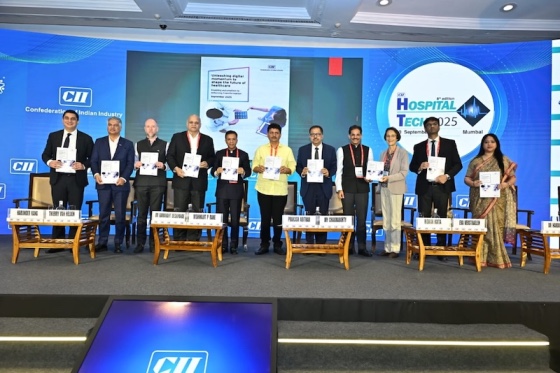- Home
- health
- CII–EY HealthTech survey 2025 reports 20–25 % rise in IT innovation budgets in Indian hospitals
CII–EY HealthTech survey 2025 reports 20–25 % rise in IT innovation budgets in Indian hospitals

Express Healthcare
health
9/20/2025Shathamanyu
THE REPORT OUTLINES DIGITAL INVESTMENT TRENDS, AI APPLICATIONS, BARRIERS TO ADOPTION, AND THE 5S FRAMEWORK FOR FUTURE-READY
HEALTHCARE
IT innovation budgets in Indian hospitals are set to rise by 20–25 per cent over the next two to three years, with nearly half of
healthcare providers already allocating 20–50 per cent of their spends to digital innovation, according to the Confederation of
Indian Industry (CII)–EY HealthTech Survey 2025. The report was launched at the CII Hospital Tech 2025 Summit.
The report, titled “Unleashing digital momentum to shape the future of healthcare – enabling automation to enforcing
transformation”, highlights the role of automation in patient experience, clinical outcomes, and data-driven decision making. It
also identifies barriers such as legacy systems, workforce readiness, and patient-centric delivery that hospitals must overcome to
become future-ready.
Digital investment trends
Six in ten hospitals plan to invest in IT capability building, followed by BI tools and data lakes (50 per cent). Hardware
upgrades and critical application enhancements account for 10 per cent of investment priorities, while medium-priority areas
include data management and cybersecurity.
AI adoption in clinical areas
Healthcare providers are prioritising AI for clinical documentation and data analysis (72 per cent), decision support systems (64
per cent), and imaging (60 per cent). These applications are being adopted to enhance visibility of clinical data and generate
insights to assist doctors, providers, and patients.
Joy Chakraborthy, Chairman, CII HospiTech 2025, said, “For India to unlock the full potential of HealthTech, collaboration across
government, industry, and providers will be critical. The next wave of healthcare delivery will be defined by how quickly we can
bridge these gaps and enable hospitals to scale innovation without compromising patient trust or data security. The CII-EY
HealthTech Survey 2025 provides a timely roadmap for healthcare leaders navigating a fast-changing landscape.”
Reflecting on the findings, Ankur Dhandharia, Partner – Healthcare, EY Parthenon India, said, “Our survey highlights both the
current state, hurdles and ambition of India’s healthcare sector and makes it clear that leaders have put in place scalable
systems and are now prioritising digital investments to create a seamless patient journey and improve health outcomes. When it
comes to AI and analytics adoption, there is a clear shift reflecting move away from pilots to practical, scalable use cases that
enhance efficiency and drive data driven decision making. Further, key government initiatives such as ABDM and DPDPA are expected
to enable and accelerate this journey. Over the next few years, we expect to see technology in healthcare move from foundational
to truly ‘future ready’ – where smart hospitals are patient-centric, efficient, data-driven and health outcome focussed.”
Barriers to digital adoption
The survey found that 60 per cent of healthcare service providers identify capability building and IT team upskilling as the
biggest challenge. Fifty per cent reported difficulties in integrating data and driving adoption of BI tools.
Hardware, network infrastructure, and data storage were reported as moderately challenging, while nearly 60 per cent of
respondents admitted to ongoing struggles with data management. Cybersecurity and patient engagement platforms were also cited as
pressure points.
Organisational readiness was flagged as a recurring hurdle. Nearly 60 per cent of CIOs cited resistance to change among
stakeholders as their biggest challenge, while 40 per cent pointed to the difficulty of integrating new applications with legacy
systems.
Privacy and protection
All leading providers reported having strong internal data privacy and protection policies supported by third-party audits and
ISO/HIPAA compliance measures. The survey found that hospitals consider privacy and compliance as strategic enablers for ensuring
patient confidence and supporting digital adoption.
Adoption of Ayushman Bharat Digital Mission (ABDM)
The survey indicated that half of healthcare providers have partially adopted ABDM, while 40 per cent are planning adoption in the
near future. The report noted that despite intent, many providers are struggling to operationalise ABDM at scale.
EY’s 5S framework for future-ready healthcare
EY experts emphasised that the transition from a digitally enabled hospital to a future-ready smart hospital is a phased process.
The 5S framework recommended includes:
* Scalable infrastructure: Secure and flexible IT systems to support expansion and integration of digital services.
* Seamless patient engagement: Use of AI, telemedicine, and wearables to create personalised and continuous care.
* Strategic data usage: Unified data systems to enable real-time insights, predictive analytics, and AI-driven decisions.
* Strengthen sustainability and compliance: Integration of privacy, cybersecurity, and sustainable practices to meet regulations
and enhance resilience.
* Smart AI and automation: Use of AI and automation to streamline administrative tasks, support diagnostics, and improve clinical
decision-making
Recent news
Related News

Balancing Innovation and Safety: The Ethical Dilemma of New Surgical Techniques
9/21/2025 Shathamanyu


New AI model predicts susceptibility to over 1,000 diseases
9/20/2025 Shathamanyu

Hospitals may raise IT innovation spend by 20-25% amid AI boost: Report
9/20/2025 Shathamanyu